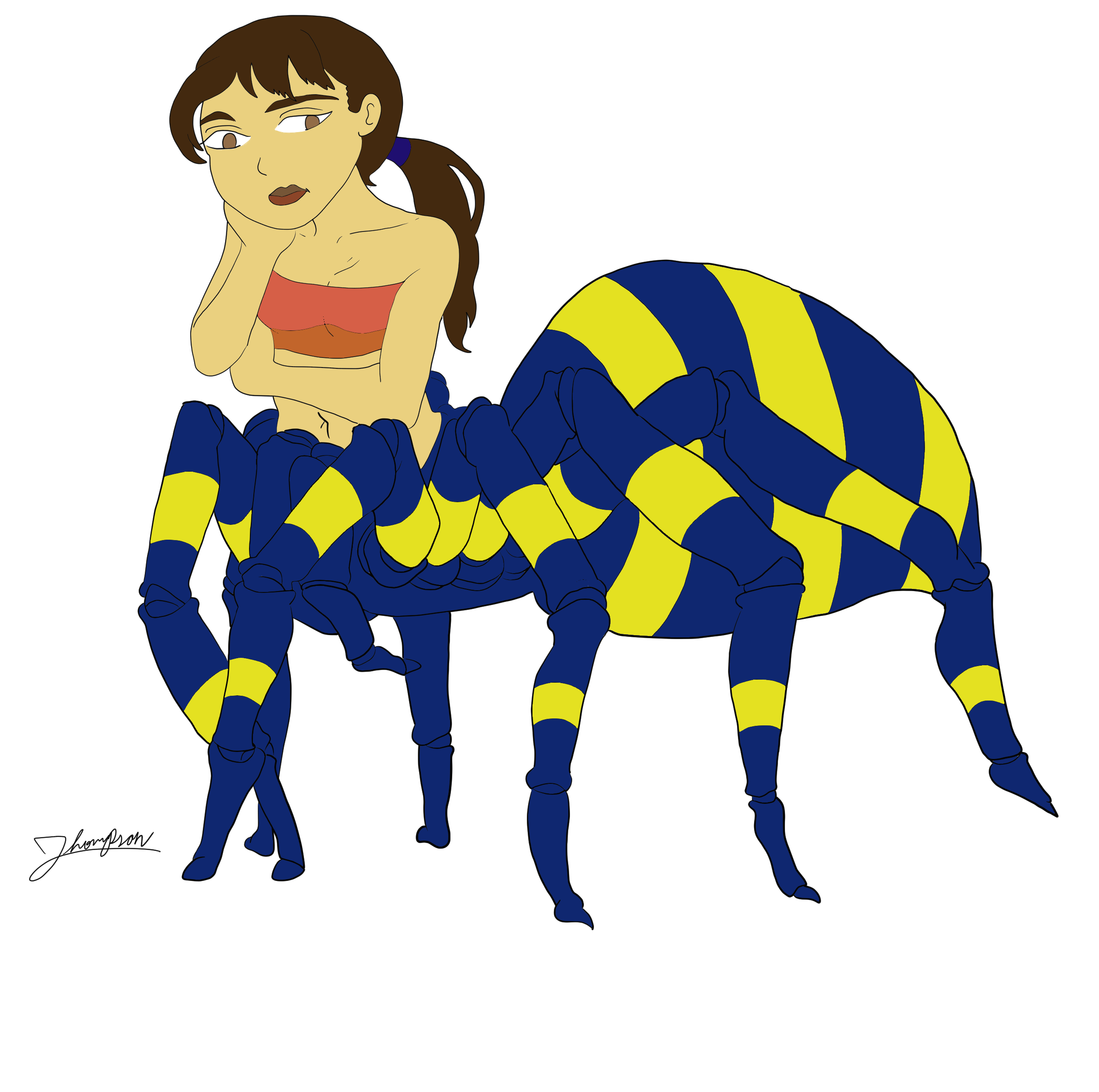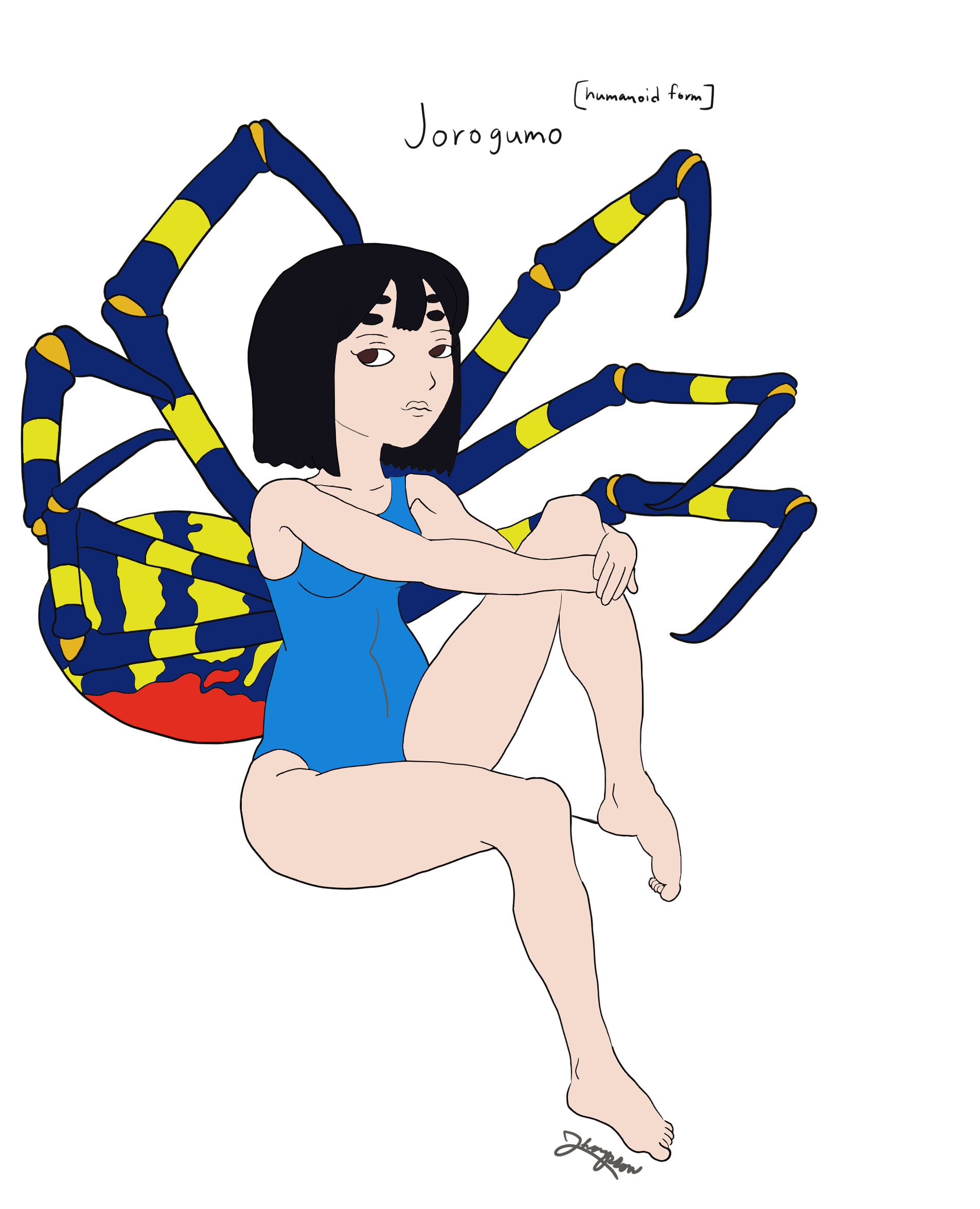Jorogumo
Jorōgumo are a Magic Beast species descended from the Joro spider, a type of golden orb web weaver. All jorogumo are female and require a humanoid male in order to reproduce their kind. Unlike most magic beasts, they do not have a purely animal form; instead, they are creatures with the upper body of a humanoid woman and the lower body of a large spider that dwells in dark places such as caves and deep within forests. They have a reputation for changing their appearance into that of a seductive human woman to attract and kidnap travelers to sire offspring.
Basic Information
Anatomy
The Arachne is their demihumanoid form that appears as human female from the hips upward merged with the abdomen and legs of a spider. The section that bridges the humanoid torso to their lower half is called the prosoma, and their secondary arachnid abdomen is called the opisthosoma. This section has the distinctive features of
black legs with yellow-orange stripes and a bright yellow body with bluish-green stripes on their back and red markings on their underside. Both arachnid somas lack any internal skeleton or extensor muscles, instead relying on hydraulic pressure to move their legs.
Jorogumo can take on an alternate form of a fully humanoid body with a shrunken version of their spider abdomen (opisthosoma) extending from the base of their spine but no spider prosoma. Also, in addition to their humanoid arms, they have six fully dexterous "spider legs" attached to their upper back which they can hide beneath their clothing should they choose.
Biological Traits
Exoskeleton: Jorogumo have varying amounts of a chitin covering covering their bodies depending on their current form. The arachne form's prosoma and opisithosoma are covered in chitin, as well as their arachnid legs.
Silk production: Jorogumo are able to create a silk that is five times stronger than steel and twice as elastic as nylon. They also produce variants of the silk, ranging from sticky, stretchy, to tough to suit whatever situation is required. Thankfully for them, the webbing does not adhere to their bodies, enabling a Jorogumo to traverse another’s web with ease. While possessing a primary spinneret within their secondary abdomen from which they are able to produce and emit silk like a spider, jorogumo also possess smaller spinnerets in their wrists and are able to emit silk from there. Various uses include building a nest, safety ropes, traps for prey, trapping bolas, and even parachutes for younger ones.
Venom Generation: Jorogumo have two tiny needle like fangs that can deliver two types of venom. One is a neurotoxin that paralyzes and the other is a hemotoxin that digests flesh it is injected into, making it easy for the jorogumo to drink the insides.
Caffeine Intoxication: Jorogumo can become intoxicated from ingesting caffeine, exhibiting poor motor skills, slurred speech, and general drunkenness.
Wallcrawling: Jorogumo have thin hairs on their legs and hands that allow them to cling to a multitude of surfaces.
Shapeshifting: Arachne develop the ability to shapeshift from their liminal Arachne form to into a mostly humanoid form and vice versa.
Genetics and Reproduction
A jorogumo requires a humanoid male for reproduction via internal intercourse. Her children develop internally in the jorogumo's abdomen and gestate roughly 9 months. Jorogumo will only give birth to other female jorogumo but many have genetic traits of the father. Also, unlike spiders, jorogumo tend to only have 1 daughter, sometimes 2.
Growth Rate & Stages
Newborn jorogumo will be nursed by their mother's milk for almost a year. The latter half of that year, her mother will introduce scraps of solid food until she weans her child off her milk. They will stay with their mother to learn how to weave webs and hunt for food during their childhood. Once she reaches puberty around the age of twenty, the nearly grown jorogumo will set out to make her own nest.
Ecology and Habitats
Mainly temperate forests, jungles, and caves; occasionally urban areas and large trees
Dietary Needs and Habits
Form the time they can eat solid food, they start off with insects and work their way up to larger prey such as birds, even small lizards and mammals. The majority discover that an Arachne form not only allows them to hunt more efficiently but it allows them to diversify their diet and include larger prey. They have two methods of feeding. Either eating their food in chunks, or they immobilize their victims and use hemotoxic venom to slowly liquefy their internal organs into a soup, sucking them out much like a normal spider.
Biological Cycle
Jorogumo have to periodically molt their exoskeleton every few months or so, often seasonally.
Additional Information
Uses, Products & Exploitation
Jorogumo build their nests using the threads produced by their body and besides that, they are proficient at sewing. Clothes made from their own thread are high grade products due to both material and craftsmanship. They sell in the marketplace for extremely high sums. The dragline silk is said to have many uses, such as: bulletproof vests, sutures after an operation, tennis rackets, fishing line, and nets.
Facial characteristics
Narrow eyes with noticeable puffiness underneath, single epicanthal eyelid fold common, small noses with low nasal bridges common, prominent cheekbones
Geographic Origin and Distribution
Yaojing region
Average Intelligence
Sapient
Perception and Sensory Capabilities
Multiple Eyes: Jorogumo have two primary eyes similar to humans and additional smaller eyes above them in the forehead area. Most have six eyes in total, but numbers can vary among individuals such as 4 or 8 in total. All eyes are capable of seeing ultraviolet light as well as visible.
Spider Sense: Jorogumo are incredibly sensitive to air pressure and movements from a distance due to a combination of spider traits, granting a hyperawareness of their immediate surroundings at the limits of the physically possible. Tactile hairs on their skin and arachnid legs are sensitive enough to feel touches just before they happen. Trichobothria are small sensitive hairs in the same area that feel for fluid flow like the slightest breeze or even the pressure of a laser pointer. Slit sensilla in the joints of their opisthosoma legs, and the sinovial cavities of their humanoid joints can feel the tiny forces or vibrations applied near them.
Civilization and Culture
Courtship Ideals
Jorogumos are seductive schemers who traditionally secret themselves away in isolated areas where they lured potential mates, to their domiciles. Aside from those living in forested areas, there are also many that change into humanoid form and live in settlements.
In recent times, there have been jorogumo who are more openly social towards other inhabitant species, especially towards potential mates who are their type.
Common Myths and Legends
The Myth of Joro Falls
Genetic Ancestor(s)
Scientific Name
Nephila clavata obake
Lifespan
400 years
Conservation Status
Vulnerable
Average Height
arachne: 183 - 213 cm (6-7 ft) ; humanoid: 149 -165 cm (4'11'' - 5'5'')
Average Weight
arachne: 59 -99 kg (130 -220 lbs) ; humanoid: 42 - 68 kg (92 - 150 lbs)
Average Physique
Petite to Slim





Comments